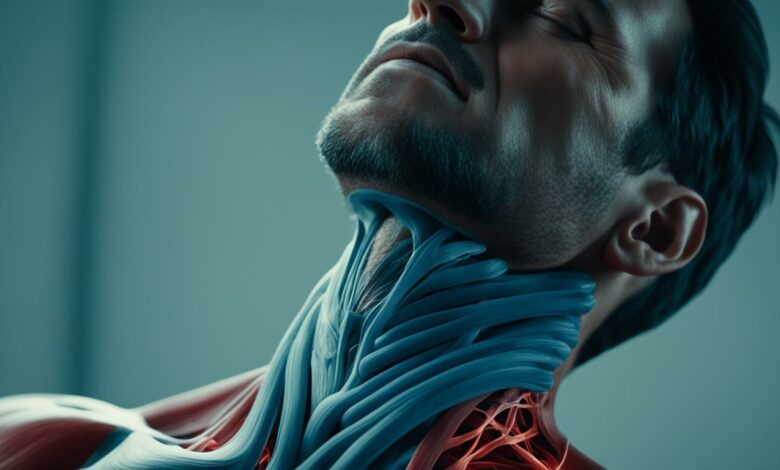
If you’ve ever experienced a severe headache that’s located at the back of your neck, you know just how debilitating it can be. Migraine pain back of neck, also known as a neck migraine, can leave you feeling exhausted and unable to function normally.
In this article, we’ll delve into the common causes of migraine pain at the back of the neck and explore relief options available to help alleviate the pain. Whether you’re experiencing neck pain as a side effect of migraines or have developed migraines due to muscle tension, this article will provide valuable insights and strategies to help you manage your symptoms.
Key Takeaways
- Migraine pain at the back of the neck can be caused by a variety of factors, including muscle tension, poor posture, and nerve compression.
- Relief options for migraine pain may include medication, lifestyle changes, and complementary therapies.
- Identifying and addressing trigger points is an important step in managing chronic migraines.
- Lifestyle changes such as stress management, regular exercise, and a healthy diet can help prevent or reduce the frequency and intensity of migraine pain.
- It’s important to work with a healthcare professional to develop a personalized plan for managing your migraine pain.
Understanding Migraines and Neck Pain
When it comes to migraines, neck pain is a common symptom experienced by many. Understanding the relationship between migraines and neck pain is essential in effectively managing symptoms and preventing future episodes.
Migraines can have various causes, including genetics, hormonal changes, and environmental factors. In some cases, neck pain can be a contributing factor, either as a trigger or as a result of migraine pain.
Common migraine symptoms that may manifest as neck pain include sensitivity to light and sound, nausea, and dizziness. These symptoms can be debilitating and impact daily life, making it crucial to seek effective relief options.
Tip: If you experience frequent migraines with neck pain, keep a journal to track potential triggers and symptoms. This can help identify patterns and aid in prevention efforts.
To effectively manage migraines and neck pain, a multi-faceted approach may be necessary. Relief options can include both medical and non-medical approaches, such as medication, exercise, relaxation techniques, and lifestyle modifications.
Note: Always consult with a healthcare professional before making any changes to your treatment plan.
Migraine Causes
The exact cause of migraines is still not fully understood, but research has identified several potential factors that may contribute to their development. These include:
| Potential Migraine Causes | Description |
|---|---|
| Genetics | Family history can increase the likelihood of developing migraines |
| Hormonal changes | Fluctuations in estrogen levels can trigger migraines in some individuals |
| Environmental factors | Stress, certain foods, and changes in weather or barometric pressure can all be triggers for migraines |
Neck Pain and Migraine Triggers
Neck pain can be both a trigger and symptom of migraines. Tension in the neck muscles can lead to headaches or migraines, while pre-existing migraines can also cause neck pain as a symptom.
When experiencing neck pain alongside migraines, it’s essential to address both symptoms holistically to alleviate discomfort and prevent future episodes.
Migraine Symptoms
Migraine symptoms can vary from person to person and may include:
- Intense headache pain, typically on one side of the head
- Sensitivity to light and sound
- Nausea and vomiting
- Dizziness or lightheadedness
- Blurred vision or other vision changes
- Tingling or numbness in the face or extremities
If you experience any of these symptoms along with neck pain, it’s crucial to speak with a healthcare professional for proper diagnosis and treatment.
Trigger Points and Migraine Pain
Migraine trigger points are specific areas of the body that can activate or worsen migraine pain. These trigger points can be found in various areas of the body, but the back of the neck is a common location for migraine sufferers. Trigger points can cause chronic migraines, making it important to identify and address them.
One common trigger point for migraine pain in the back of the neck is the suboccipital muscle group. These muscles are located at the base of the skull and can become tight or tense, leading to pain and discomfort. Other trigger points in the neck and shoulders can also contribute to migraine pain.
Identifying trigger points can be challenging but can be achieved through a physical examination by a healthcare provider or a trained professional. Once identified, trigger points can be treated through different methods, including massage therapy and trigger point injections.
It’s important to remember that identifying and treating trigger points is just one part of managing migraine pain. Different individuals may have different trigger points, and migraine pain can be caused by a variety of factors. It’s essential to work with a healthcare provider to develop a personalized treatment plan.
To learn more about trigger points and migraine pain, refer to the following table:
The importance of treating migraine trigger points
“Trigger point therapy has been found to be an effective form of treatment for migraine pain. Identifying and treating trigger points in the back of the neck can help manage and reduce the frequency and intensity of migraine attacks.”
Common Causes of Migraine Pain at the Back of the Neck
Migraine pain at the back of the neck can be caused by a variety of factors:
- Muscle tension: Tight muscles in the neck and upper back can lead to pain and tension headaches, which may trigger migraines.
- Posture: Poor posture, such as hunching over a computer for long periods, can strain the neck muscles and cause pain.
- Nerve compression: A pinched nerve in the neck can cause pain that radiates to the head, resulting in a migraine.
- Mental stress: Stress and anxiety can cause muscle tension in the neck and trigger migraines.
- Dehydration: Lack of water in the body can cause headaches, including migraines, which can result in neck pain and discomfort.

It’s important to identify the causes of your migraines to effectively manage your symptoms and prevent future headaches.
If your migraines are triggered by any of these causes, there are treatments that can help. Neck stretches and exercises, physical therapy, and stress-reducing techniques can all help alleviate pain and prevent further migraine attacks. It’s important to speak with your healthcare provider to determine the best course of treatment for you.
Relief Options for Migraine Pain at the Back of the Neck
If you’re experiencing migraine pain at the back of your neck, relief options are available. Here are some medical and non-medical approaches to alleviate the pain:
1. Medications
Over-the-counter pain relievers such as ibuprofen, acetaminophen, or aspirin can provide relief for mild to moderate migraines. If your migraines are severe, prescription medications such as triptans or ergots may offer better relief.
2. Complementary Therapies
Complementary therapies such as acupuncture, massage, or chiropractic care can help reduce the severity and frequency of migraines.
3. Lifestyle Changes
Lifestyle changes can play a significant role in preventing migraines. Eating regular meals, getting enough sleep, and reducing stress levels can all reduce the frequency and severity of migraines.
4. Cold Therapy
Applying a cold compress to the neck or forehead can help alleviate pain associated with migraines. You can use a pack of frozen vegetables or a cold gel pack wrapped in a towel.

These relief options can be used in conjunction with each other for maximum effect. Consult with your healthcare provider before starting any treatment regimen. With the appropriate treatment plan, you can manage migraine pain and lead a healthy, fulfilling life.
Lifestyle Changes to Prevent Migraine Pain
If you’re looking for ways to reduce the frequency and pain of back-of-the-neck migraines, lifestyle changes can be a natural and effective treatment option. A combination of stress management techniques, regular exercise, and a healthy diet can help prevent the onset of migraines and minimize their impact on your life.
Stress Management
Stress is a common trigger for migraines, so learning how to manage it can be key to preventing them. Consider incorporating relaxation techniques like meditation, yoga, or deep breathing exercises into your daily routine. Avoid overextending yourself, and practice saying “no” when you feel overwhelmed.
Regular Exercise
Regular exercise can not only promote overall health but also reduce the frequency and intensity of migraines. Choose low-impact exercises like swimming or yoga, and aim for 30 minutes of physical activity each day. Be sure to speak to your doctor before starting any new exercise routine.
Healthy Diet
The foods you eat can also have an impact on your migraines. Certain trigger foods like caffeine, alcohol, and processed foods should be avoided. Instead, focus on consuming fresh fruits and vegetables, lean proteins, and whole grains. Staying hydrated by drinking plenty of water throughout the day is also important.
By implementing these lifestyle changes, you can gain control over your migraines and improve your overall quality of life.
Understanding Indigestion Causes: Your Guide to Healthy Digestion
Conclusion
Debilitating migraine pain at the back of the neck can cause severe headaches and neck pain, impacting daily life. Fortunately, relief options are available to alleviate symptoms and prevent further attacks. Understanding the causes and potential triggers for this type of migraine, as discussed in this article, is crucial for identifying effective relief options.
From medical treatments such as medications to complementary therapies like acupuncture, there are various ways to help manage migraine pain. Lifestyle changes such as stress management and regular exercise can also be effective for preventing migraines.
If you are experiencing migraine pain at the back of the neck, know that relief is possible. Consult with a healthcare professional to identify the best treatment plan for you. With the right approach, you can manage your symptoms and get back to enjoying your everyday life.



